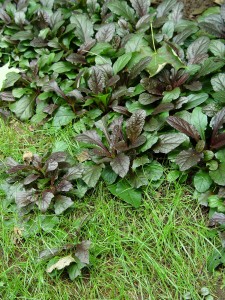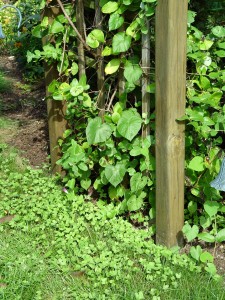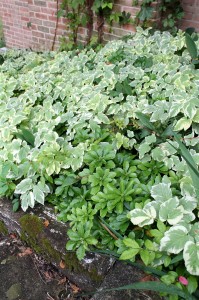The Perils of Pass-along Plants
January 11th, 2013
Warning: Be wary of gardeners bearing gift plants.
If you’re on the giving end, I know it’s tough to bear the thought of simply chucking anything living that might grow somewhere else. If you’re on the receiving end, yeah, you might get a great new plant for free. But you might also unwittingly get someone else’s invader. My own garden has a gorgeous velvet-purple bearded iris that came from an iris-doting friend, and my first Polianthes tuberose (a tremendously fragrant white-blooming tender rhizome) also came via the freebie route.
The trick is sorting out the good stuff from the pass-alongs that don’t know when to quit.
If you’re not familiar with an offered plant, ask the giver how much it spreads and how often he or she has to thin it out. Also ask about how freely it seeds, because some plants churn out seedlings for years all over the yard. (Hardy ageratums and bronze fennel are two that come to my mind.)
With any luck, the giver will know the name of the plant. Look it up in a good garden book or run an Internet search. Be wary if the descriptions mention words such as “invasive,” “aggressive” or catalog-writers’ favorite code word, “vigorous.”
Also decide if you like the look and habit of the plant. Ask yourself if there’s a spot in your yard where it’ll fit in and make sense. Don’t ruin an otherwise nice design with a newcomer just because it came free.
Where you decide to plant a pass-along also can make a big difference.
Example: A neighbor may have a planting of variegated lamiastrum or ajuga that looks pretty good mass-planted under a big shade tree. But if you take divisions of those same plants and put them in good soil in a perennial border, they’ll be doing takeovers faster than the banking industry. The lesson is that aggressive species sometimes make sense when they’re harnessed by dry shade and root competition and/or given plenty of unimpeded space to spread. Remove those checks, though, and it’s like unleashing smallpox on a new town.
You’ve got to figure that most pass-alongs are at least mildly invasive or else people wouldn’t be digging them up and trying to give them away.
This is where your level of maintenance comes into play.
It’s perfectly normal for many perennial flowers to need some dividing and thinning every few years. Daylilies, black-eyed susans, veronica, yarrow and most of the ornamental grasses fit into this category.
Others are a bit more aggressive and ideally should be culled every year or two. Things like beebalm, obedient plants (Physostegia), ajuga and tall garden phlox fit into that category.
To one gardener, that’s just part of gardening. To another, it’s invasiveness.
If you don’t like dividing and thinning every year or two, stick with perennials that can go many years without dividing, such as hosta, sedum, hardy geraniums and helleborus. (Two excellent resources for perennial maintenance are Tracy DiSabato-Aust’s “The Well-Tended Perennial Garden,” Timber Press, 2006, $34.95, and Nancy Ondra’s “The Perennial Care Manual,” Storey Publishing, 2009, $24.95.)
Then you’ve got plants that cross over from being “regular dividers” into “garden thugs.”
These are the plants that creep so fast that new shoots pop up as fast as you yank out the trespassing ones.
They’re the ones that reseed so wildly that you find yourself pulling out hundreds of unwanted seedlings the following spring for every one you’d like to keep. They’re the ones that are so aggressive that they’ve managed to earn a spot on some states’ invasive-plant lists – the same lists that include botanical disasters such as giant hogwood, mile-a-minute weed and tree-of-Heaven.
A few plants you might run across that are high on my thug list:
* Purple loosestrife (Lythrum salicaria). A tough, pretty, long-blooming perennial with spiky pink-purple flowers. Pennsylvania banned its sale after even bred varieties were found to cross-breed with the wild species that’s clogging waterways all over the state.
* Chameleon plant (Houttuynia). A short groundcover with beautiful multi-colored leaves. Problem is, it doesn’t when to quit. It sends out shoots everywhere, especially in a garden setting.
* Bamboo. Some types are fairly well-behaved clump-formers, but the spreading types can even put out runners under a driveway and come up on the other side. Your neighbors will curse you as it creeps onto their property.
* Ribbon grass (Phalaris arundinacea var. Picta). A white-edged grass that spreads mercilessly in damp soil. It might look good in spring or wet years but usually browns out at the base in hot, dry summers.
* Lemon balm (Melissa officinalis). Sometimes known as “the herb from Hell.” It smells lemony fresh and the leaves are a lush green in color, but it creeps and seeds and roots to the point where most gardeners end up ripping it all out.
* Spearmint (Mentha spicata). Another nice-smelling herb that’ll creep for miles if you let it. If you get a division, grow it in a big pot, not in the ground (unless you encase it in a buried chimney flue).
A few others that cross my line: Bishop’s weed (Aegopodium podagraria)
Lily-of-the-valley (Convallaria majalis)
Snow-in-summer (Cerastium tomentosum)
Dame’s rocket (Hesperis matronalis)
Porcelain-berry (Ampelopsis brevipedunculata)
Morrow’s honeysuckle (Lonicera morrowii)
Tartarian honeysuckle (Lonicera tatarica)
Japanese honeysuckle (Lonicera japonica)
Crown vetch (Coronilla varia)
English ivy (Hedera helix)
Johnny-jump-ups (Viola tricolor)











